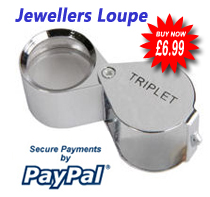 The
quality of gold is measured in carats. As everybody knows, the higher
the carat the better the quality of the gold but how do you measure it
and what does it mean?
The
quality of gold is measured in carats. As everybody knows, the higher
the carat the better the quality of the gold but how do you measure it
and what does it mean?The word carat comes from the Arabic word qirat and means seed pod or husk, traditionally used to weigh small quantities.
The Greeks used the same measure and found it was the equivalent of a Roman measurement, the siliqua. This was one 24th of a gold Roman coin – the solidus of Constantine.
Today for gold measurement, this idea of the 24 units lives on.
However the amount of carats contained in gold does not relate to the weight of the gold, just the purity.
By contrast, diamonds and precious gemstones also measured in carats, refer to weight. A gemstone carat weighs 0.2mg.
Gold is a very soft metal and used alone it is far too soft for many applications such as jewellery, as well as being expensive.
For these reasons it is usually mixed with another metal such as silver, copper or nickel to increase the hardness.

The content of the gold is measured in units of 24ths or carats, sometimes spelt karats.
If a piece of jewellery is 18 carat gold this means that it is 18 parts gold and the remaining 6 units are made up of another metal. For nine-carat gold, the majority of the metal is base metal with only 9/24 of gold. This equals 37.5% gold or 375 parts per 1000. The weight of the gold does not affect the carat value.
Fine Gold
The purest gold available is 24 carat gold, also called fine gold. This means that out of the 24 units of gold, the full 24 are gold. To be more precise, .9995 parts per 1000 or 99.95% is gold.
If this is converted to carats, it would be 23.988 carats or more likely 99.9% because of the residual impurities found in the metal.
The Royal Canadian Mint produce a .99999 fine gold coin which is advertised as the world's purest gold coin. Gold bars and ingots are classed as fine gold if they are over .995 which is 23.88 carats.

Buy A Jewellers magnifying Loupe for £6.99
Gold and silver hallmarks main site

